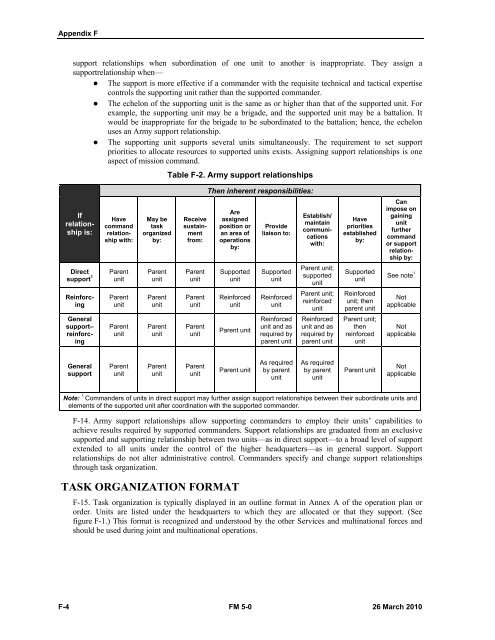FM 5-0, The Operations Process - Federation of American Scientists
FM 5-0, The Operations Process - Federation of American Scientists
FM 5-0, The Operations Process - Federation of American Scientists
You also want an ePaper? Increase the reach of your titles
YUMPU automatically turns print PDFs into web optimized ePapers that Google loves.
Appendix F<br />
support relationships when subordination <strong>of</strong> one unit to another is inappropriate. <strong>The</strong>y assign a<br />
supportrelationship when—<br />
• <strong>The</strong> support is more effective if a commander with the requisite technical and tactical expertise<br />
controls the supporting unit rather than the supported commander.<br />
• <strong>The</strong> echelon <strong>of</strong> the supporting unit is the same as or higher than that <strong>of</strong> the supported unit. For<br />
example, the supporting unit may be a brigade, and the supported unit may be a battalion. It<br />
would be inappropriate for the brigade to be subordinated to the battalion; hence, the echelon<br />
uses an Army support relationship.<br />
• <strong>The</strong> supporting unit supports several units simultaneously. <strong>The</strong> requirement to set support<br />
priorities to allocate resources to supported units exists. Assigning support relationships is one<br />
aspect <strong>of</strong> mission command.<br />
Table F-2. Army support relationships<br />
<strong>The</strong>n inherent responsibilities:<br />
If<br />
relationship<br />
is:<br />
Have<br />
command<br />
relationship<br />
with:<br />
May be<br />
task<br />
organized<br />
by:<br />
Receive<br />
sustainment<br />
from:<br />
Are<br />
assigned<br />
position or<br />
an area <strong>of</strong><br />
operations<br />
by:<br />
Provide<br />
liaison to:<br />
Establish/<br />
maintain<br />
communications<br />
with:<br />
Have<br />
priorities<br />
established<br />
by:<br />
Can<br />
impose on<br />
gaining<br />
unit<br />
further<br />
command<br />
or support<br />
relationship<br />
by:<br />
Direct<br />
support 1<br />
Parent<br />
unit<br />
Parent<br />
unit<br />
Parent<br />
unit<br />
Supported<br />
unit<br />
Supported<br />
unit<br />
Parent unit;<br />
supported<br />
unit<br />
Supported<br />
unit<br />
See note 1<br />
Reinforcing<br />
Parent<br />
unit<br />
Parent<br />
unit<br />
Parent<br />
unit<br />
Reinforced<br />
unit<br />
Reinforced<br />
unit<br />
Parent unit;<br />
reinforced<br />
unit<br />
Reinforced<br />
unit; then<br />
parent unit<br />
Not<br />
applicable<br />
General<br />
support–<br />
reinforcing<br />
Parent<br />
unit<br />
Parent<br />
unit<br />
Parent<br />
unit<br />
Parent unit<br />
Reinforced<br />
unit and as<br />
required by<br />
parent unit<br />
Reinforced<br />
unit and as<br />
required by<br />
parent unit<br />
Parent unit;<br />
then<br />
reinforced<br />
unit<br />
Not<br />
applicable<br />
General<br />
support<br />
Parent<br />
unit<br />
Parent<br />
unit<br />
Parent<br />
unit<br />
Parent unit<br />
As required<br />
by parent<br />
unit<br />
As required<br />
by parent<br />
unit<br />
Parent unit<br />
Not<br />
applicable<br />
Note: 1 Commanders <strong>of</strong> units in direct support may further assign support relationships between their subordinate units and<br />
elements <strong>of</strong> the supported unit after coordination with the supported commander.<br />
F-14. Army support relationships allow supporting commanders to employ their units’ capabilities to<br />
achieve results required by supported commanders. Support relationships are graduated from an exclusive<br />
supported and supporting relationship between two units—as in direct support—to a broad level <strong>of</strong> support<br />
extended to all units under the control <strong>of</strong> the higher headquarters—as in general support. Support<br />
relationships do not alter administrative control. Commanders specify and change support relationships<br />
through task organization.<br />
TASK ORGANIZATION FORMAT<br />
F-15. Task organization is typically displayed in an outline format in Annex A <strong>of</strong> the operation plan or<br />
order. Units are listed under the headquarters to which they are allocated or that they support. (See<br />
figure F-1.) This format is recognized and understood by the other Services and multinational forces and<br />
should be used during joint and multinational operations.<br />
F-4 <strong>FM</strong> 5-0 26 March 2010















